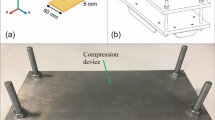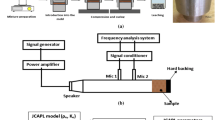Abstract
Conventional manufacturing techniques of natural rubber foam (NRF) require long processing time besides producing closed cell structure, a property that limits the application of the NRF. The NRF produced via compression moulding (CPM) and microwave-convection oven heating techniques were compared in this study. The correlation between different processing techniques with the physical, morphological, and acoustic properties of NRF was examined. The results indicated that in all the processing techniques, an increase in the blowing agent (BA) led to a decrease in the density of the NRF. Heating the material sequentially with 16 parts per hundred (phr) of BA in a microwave oven at 1000 Watts, and then, in a convection oven at 150 ℃ produced NRF with a density of 0.23 g/cm3. In contrast, the NRF produced by CPM with 16 phr of BA had a density of 0.35 g/cm3. Scanning electron microscope analysis revealed that the NRF generated by CPM had fewer interconnected and more closed cells. On the other hand, sequential heating using microwave and convection heating techniques and vice versa led to the production of NRF with more open and interconnected cells. The prepared NRF was examined for acoustic properties. The results showed that the NRF produced by CPM at 12 and 16 phr of BA had the lowest ability to attenuate sound wave energy. This was due to the highly solid surface of the sample, which caused high sound wave reflection. Open and interconnected cells significantly improved the acoustic efficiency. These findings indicated that microwave-assisted heating techniques can modify the cellular structure of NRF and produce the material within a shorter period.





Similar content being viewed by others
References
Vahidifar A, Khorasani SN, Park CB, Naguib HE, Khonakdar HA (2016) Fabrication and characterization of closed-cell rubber foams based on natural rubber/carbon black by one-step foam processing. Ind Eng Chem Res 55:2407–2416. https://doi.org/10.1021/acs.iecr.5b04448
Najib NN, Ariff ZM, Bakar AA, Sipaut CS (2011) Correlation between the acoustic and dynamic mechanical properties of natural rubber foam: effect of foaming temperature. Mater Des 32:505–511. https://doi.org/10.1016/j.matdes.2010.08.030
Rostami-Tapeh-Esmaiel T, Vahidifar A, Esmizadeh E, Rodrigue D (2021) Chemistry, processing, properties, and applications of rubber foams. Polymers 13:1565–1615. https://doi.org/10.3390/polym13101565
Pechurai W, Muansupan T, Seawlee P (2014) Effect of foaming temperature and blowing agent content on cure characteristics, mechanical and morphological properties of natural rubber foams. Adv Mater Res 844:454–457. https://doi.org/10.4028/www.scientific.net/amr.844.454
Ariff ZM, Afolabi LO, Salmazo LO, Rodriguez-Perez MA (2020) Effectiveness of microwave processing approach and green blowing agents usage in foaming natural rubber. J Mater Res Technol 9:9929–9940. https://doi.org/10.1016/j.jmrt.2020.06.096
Abbad A, Jaboviste K, Ouisse M, Dauchez N (2018) Acoustic performances of silicone foams for sound absorption. J Cell Plast. 54:651–670. https://doi.org/10.1177/0021955X17732305
Menéndez JA, Arenillas A, Fidalgo B, Fernández Y, Zubizarreta L, Calvo EG, Bermúdez JM (2010) Microwave heating processes involving carbon materials. Fuel Process Technol 91:1–8. https://doi.org/10.1016/j.fuproc.2009.08.021
Vega B, Agulló N, Borrós S (2007) Study of the influence of microwaves in the mechanism of sulfenamide accelerated vulcanization of natural rubber using squalene as a model compound. Rubber Chem Technol 80:739–750. https://doi.org/10.5254/1.3539413
Sombatsompop N, Kumnuantip C (2006) Comparison of physical and mechanical properties of nr/carbon black/reclaimed rubber blends vulcanized by conventional thermal and microwave irradiation methods. J Appl Polym Sci 100:5039–5048. https://doi.org/10.1002/app.23472
Prociak A, Michalowski S, Bak S (2012) Thermoplastic polyurethane foamed under microwave irradiation. Polimery. 57:786–790. https://doi.org/10.14314/polimery.2012
Ahmad Zauzi NS, Ariff ZM, Shuib RK (2022) Development of natural rubber foam with water as a blowing agent via microwave and convection heating methods. Express Polym Lett 16:296–317. https://doi.org/10.3144/expresspolymlett.2022.23
Doutres O, Salissou Y, Atalla N, Panneton R (2010) Evaluation of the acoustic and non-acoustic properties of sound absorbing materials using a three-microphone impedance tube. Appl Acosut 71:506–509. https://doi.org/10.1016/j.apacoust.2010.01.007
Setyowati E, Hardiman H, Purwanto P (2019) Tailoring acoustic performances of resin reinforced biomass fiber-based panel with single and multiple tailed cavity inclusions for interior work. Fibers 7:1–22. https://doi.org/10.3390/fib7100085
Najib NN, Ariff ZM, Manan NA, Bakar AA, Sipaut CS (2009) Effect of blowing agent concentration on cell morphology and impact properties of natural rubber foam. J Phys Sci 20:13–25
Samsudin MSF, Ariff ZM, Ariffin A (2017) Deformation behavior of open-cell dry natural rubber foam: effect of different concentration of blowing agent and compression strain rate. AIP Conf Proc. 1385:020007. https://doi.org/10.1063/1.4981829
Zakaria Z, Ariff ZM, Hwa TL, Sipaut CS (2007) Effect of foaming temperature on morphology and compressive properties of ethylene propylene diene monomer rubber (EPDM) foam. Malays Polym J. 2:22–30
Rostami-Tapeh-Esmaeil E, Vahidifar A, Esmizadeh E, Rodrigue D (2021) Chemistry, processing, properties, and applications of rubber foams. Polymers 13:1565. https://doi.org/10.3390/polym13101565
Bayat H, Fasihi M, Zare Y, Rhee KY (2020) An experimental study on one-step and two-step foaming of natural rubber/silica nanocomposites. Nanotechnol Rev 9:427–435. https://doi.org/10.1515/ntrev-2020-0032
Calabrò E, Magazù S (2012) Comparison between conventional convective heating and microwave heating: an FTIR spectroscopy study of the effects of microwave oven cooking of bovine breast meat. J Electromagn Anal Appl 4:433–439. https://doi.org/10.4236/jemaa.2012.411060
Chandrasekaran S, Ramanathan S, Tanmay B (2012) Microwave material processing—a review. AIChE J 58(2):330–363. https://doi.org/10.1002/aic.12766
Mandal AK, Sen R (2017) An overview on microwave processing of material: a special emphasis on glass melting. Mater Manuf Process 32:1–20. https://doi.org/10.1080/10426914.2016.1151046
Mohebbi A, Mighri F, Ajji A, Rodrigue D (2015) Current issues and challenges in polypropylene foaming: a review. Cell Polym 34:299–337. https://doi.org/10.1177/026248931503400602
Zubair M, Ferrari R, Alagha O, Mu’azu ND, Blaisi NI, Ateeq IS, Manzar MS (2020) Microwave foaming of materials: an emerging field. Polymers 12:1–39. https://doi.org/10.3390/polym12112477
Amares S, Sujatmika E, Hong TW, Durairaj R, Hamid HSHB (2017) A review: characteristics of noise absorption material. J Phys: Conf Ser 908:1–9. https://doi.org/10.1088/1742-6596/908/1/012005
Algaily B, Puttajukr S (2014) Acoustic absorption and physicomechanical properties of SBR/ Rr Foam. Int J Tech Res Appl 2:15–18
Jiang X, Wang Z, Yang Z, Zhang F, You F, Yao C (2018) Structural design and sound absorption properties of nitrile butadiene rubber-polyurethane foam composites with stratified structure. Polymers 10:946–958. https://doi.org/10.3390/polym10090946
Dunne R, Desai DA (2017) A review of porous automotive sound absorbers, their environmental impact and the factors that influence sound absorption. Int J Veh Noise Vib 13:127–163. https://doi.org/10.1504/IJVNV.2017.087910
Acknowledgements
The authors acknowledge the funding provided by Universiti Sains Malaysia through the Research University (RUI) grant (Ref. No.: 1001/PBAHAN/8014041) and Universiti Malaysia Sarawak.
Funding
This research was funded by Universiti Sains Malaysia through the Research University (RUI) grant (Ref. No.: 1001/PBAHAN/8014041) and Universiti Malaysia Sarawak.
Author information
Authors and Affiliations
Contributions
All authors contributed to the study conception and design. Experimental work, data collection and first draft of the manuscript were done by NSAZ. Analysis and manuscript review were performed by ZMA and RKS. Technical advice on the use of microwave processing approach was provided by MFA through discussion with ZMA. All authors read and approved the final manuscript.
Corresponding author
Ethics declarations
Conflict of interest
The authors declare that there is no conflict of interest.
Ethical approval
Not applicable.
Consent to participate
Not applicable.
Consent for publication
Not applicable.
Additional information
Publisher's Note
Springer Nature remains neutral with regard to jurisdictional claims in published maps and institutional affiliations.
Rights and permissions
Springer Nature or its licensor (e.g. a society or other partner) holds exclusive rights to this article under a publishing agreement with the author(s) or other rightsholder(s); author self-archiving of the accepted manuscript version of this article is solely governed by the terms of such publishing agreement and applicable law.
About this article
Cite this article
Zauzi, N.S.A., Ariff, Z.M., Shuib, R.K. et al. Physical and acoustical performance of natural rubber foam prepared via microwave and convection heating techniques. J Rubber Res (2023). https://doi.org/10.1007/s42464-023-00209-3
Received:
Accepted:
Published:
DOI: https://doi.org/10.1007/s42464-023-00209-3




